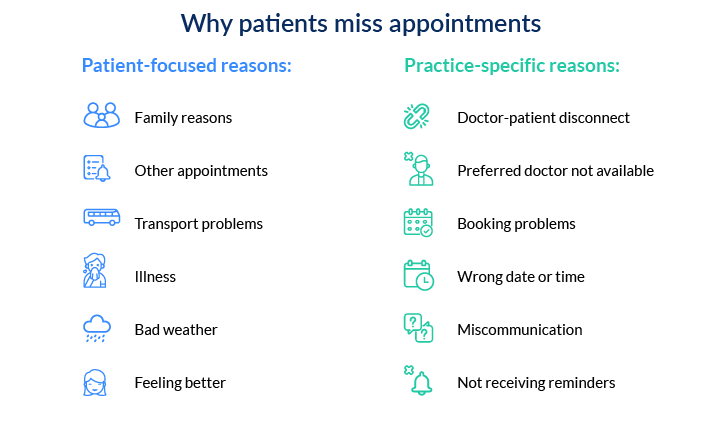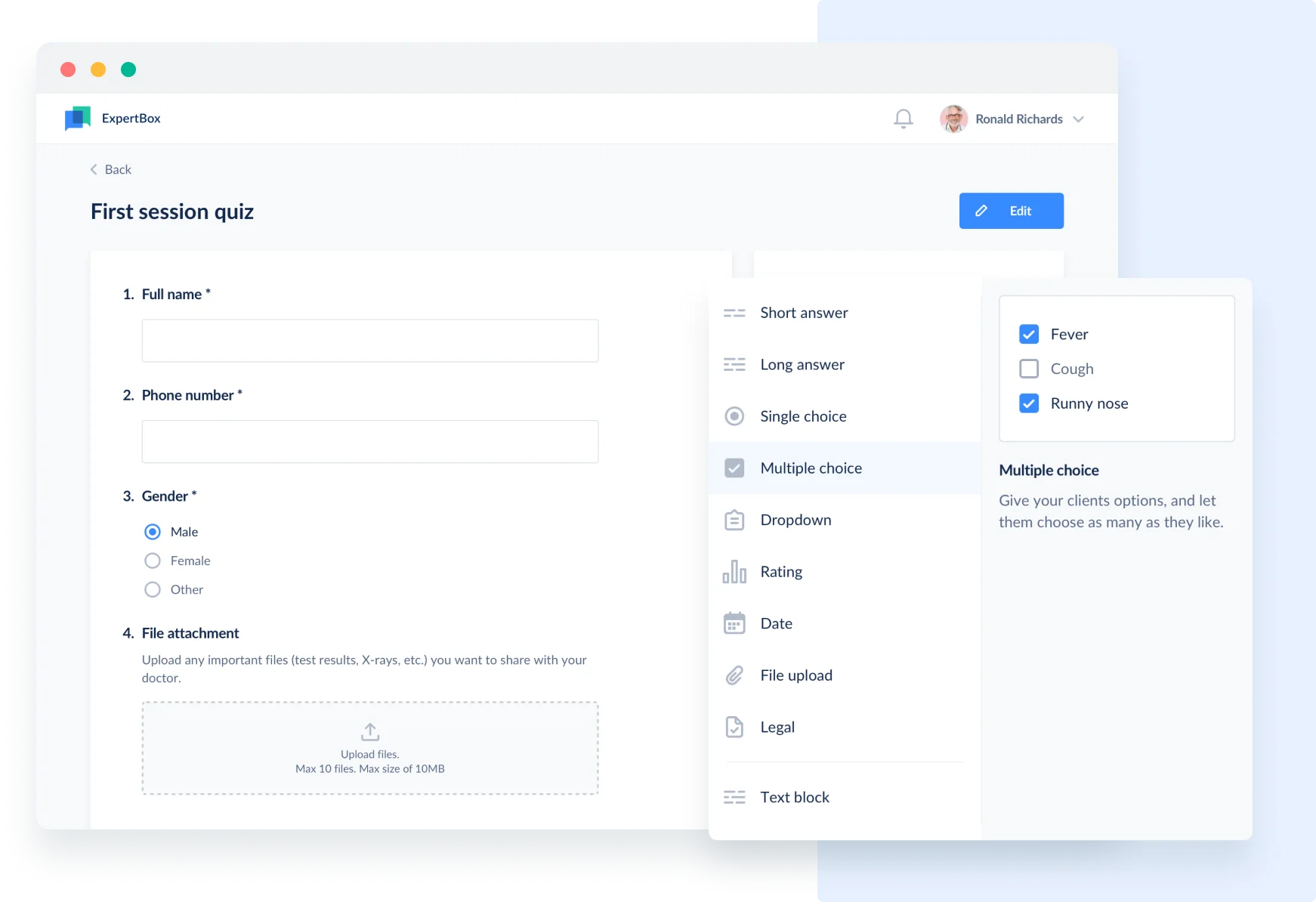Missed appointments are one of the most frustrating issues faced by every practice. A no-show can cause chaos, wasted preparation time, and lost revenue. No-shows cannot be entirely eliminated in every practice, but there are ways to reduce their number.
Statistics show that no-show patients cost individual healthcare providers $150 to $200 per missed appointment and cost U.S. healthcare providers collectively around $150 billion annually. Healthcare practice managers must adopt industry-level tools and best practices to minimize revenue losses and save valuable staff time.
Understanding why patients miss appointments helps managers better address pain points and prioritize strategies to minimize no-shows.
Why do patients miss appointments?
There are two groups of reasons why patients miss appointments according to the results of a 2021 study published in the British Journal of General Practice:

No-shows do more harm than just being a nuisance or a reason for lost revenue. Missed appointments can lead to unresolved medical problems, leaving patients vulnerable and living with untreated or worsening health.
So what can you do as a health practitioner to reduce the rate of no-shows in your practice?
How to reduce patient no-shows
There are many ways to improve attendance and decrease the number of appointments that patients miss for one reason or another. What's even better, the following strategies will also improve retention rates and may even increase the number of patients brought by referrals. Let's take a closer look.
Set up appointment reminders
By reminding patients about their upcoming appointments, you not only get their attention but also enhance patient loyalty. It's convenient for patients when their providers send them reminders, and automated reminders can save you both time and money compared to a manual system.
One option is to send email reminders when booking, one day in advance, and one hour before an appointment.

Best practices for setting up automatic appointment reminders
- Address the patient by name
- Confirm the specific doctor along with the date and time for the appointment
- Include the provider's address for ease of access
Using ExpertBox's customizable booking system, patients can quickly reschedule their own appointments without having to call the clinic. They can also cancel and rebook appointments without involving the clinic's staff.
Speak with compassion and care
Be patient and friendly with your follow-up if a patient misses an appointment. The adverse effects of guilt-tripping or negativity can cause patients to seek a new medical provider.
It is especially effective to say, "Sorry, we missed you." Sales professionals commonly use this phrase to motivate customers to continue doing business with them. Even better, practice management software such as ExpertBox allows you to send emails to patients who have missed appointments. You reduce time and monetary losses when you offer a convenient way to rebook.
Allow prepayment for appointments
Allowing patients to prepay for their appointments will encourage them to show up. When patients know their money has already been invested in an appointment, they are more likely to attend. You might offer your patients a discount if they prepay for their next visit.

Patients can easily pay online using familiar and convenient methods supported by ExpertBox. If an appointment has been canceled for a valid reason, a refund is processed automatically.
Minimize time spent in your waiting room
People are busy, so having them wait 20 to 40 minutes for an appointment may make them skip future appointments. Physician Wait Time Report found that 30% of patients abandoned appointments due to long wait times, with one in five switching doctors entirely.
British Medical Journal recommends that providers aim for a wait time of no more than 18 minutes.
Best practices to minimize waiting time
Engaging patients in the waiting room is also a good idea. You might consider:
- Providing health-related reading material
- Collecting patient reviews using tablets
- Conducting on-site surveys
Patients are more likely to value your time if you value theirs. A no-show can quickly become a lost client. Collecting essential information about the client during the appointment booking process can significantly reduce the time spent filling out forms during the actual appointment. This way, the practitioner can dedicate more time to the patient and their concerns.
Offer transportation options
It can be difficult to make appointments due to transportation problems. Providing information about public transportation options can help people make it to in-person appointments. Distributing information about public transit can be shared through
- Materials to be used before the appointment
- Regular communication with patients
- Appointment reminders
- Posters and postcards for in-office use
Partnerships with ridesharing companies can also be an effective strategy. Through its partnership with Lyft, Hennepin’s healthcare practice illustrates the potential ROI for healthcare providers:
In 2018, Hennepin partnered with Lyft to implement a 12-month pilot rideshare program. The program resulted in a 10% reduction in no-shows—from 31 to 22.5 percent and a savings of $270,000.
Another way to facilitate patient transportation is to move appointments online when possible. If the patient’s condition and the nature of the appointment allow, consider using telehealth to avoid common transportation challenges.
Always thank patients who keep appointments and arrive on time
Thanking patients increases the chance that they will show up for scheduled appointments and arrive on time. You might consider the following strategies to thank your loyal patients.
How to thank patients who show on time
- Send handwritten thank-you notes
- Sign and send holiday and birthday cards
- Create newsletters with personalization
- Send gift cards
In addition to these more immediate approaches, consider the following:
- Reducing the cost of medical bills
- Running giveaways, possibly every month
- Sending a newsletter or sharing social media posts thanking patients
As a result, patients will feel appreciated for their time and cooperation, building loyalty.
Provide telehealth appointments
No-show slots can be hard to fill at the last minute. Consider telehealth appointments as an alternative. As the first step, prepare a waiting list for your telehealth appointments. Establish an on-call list for each appointment based on patients’ typical schedules.
Why you should consider offering telehealth
There are several benefits to having an on-call telehealth list:
- Immediately fill vacant appointment slots
- Save time by automating practice administration
Don't let no-shows happen in the first place! Learn how virtual healthcare is shaping the future of healthcare. Discover the benefits of telehealth and see how telemedicine modernizes physicians' practices and clinics globally. Read the article!
Build strong relationships with patients to increase their commitment to your practice
The relationship between you and your patients can be cemented all year long. Birthday and holiday wishes can be sent by email, but you can also provide ongoing information through your website. Use a patient newsletter to keep your patients up to date about events at your office and to offer healthcare tips they can immediately apply. A patient who feels valued is much less likely to become a no-show.
Conclusion
When it comes to reducing your no-show rate, you have a variety of tips and tools at your disposal. Consider an ongoing schedule for patient communication and relationship management once you've implemented the above strategies. Positive, consistent relationships are the key to preventing no-shows and elevating your brand as a reputable care provider.
Learn about the HIPAA-compliant ExpertBox practice management and patient communication platform. Book the demo today!
FAQ
-
Reschedule as soon as possible. After waiting 10 to 15 minutes, call the patient if they haven't shown up. It is extremely important to keep this phone call in a professional tone. Keep a concern-filled tone in your voice. It's important not to sound like you're accusing them of being late.
-
According to the data analysis, five major factors contributed to patients missing scheduled appointments: forgetfulness, transportation issues, personal health issues, family and employer obligations, and other issues such as bad weather and financial difficulties.



